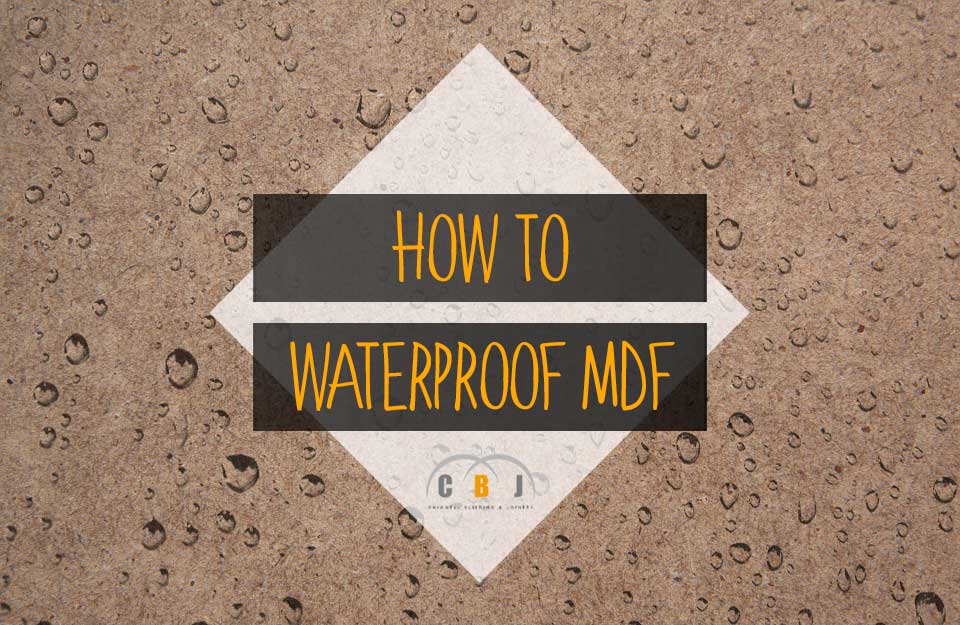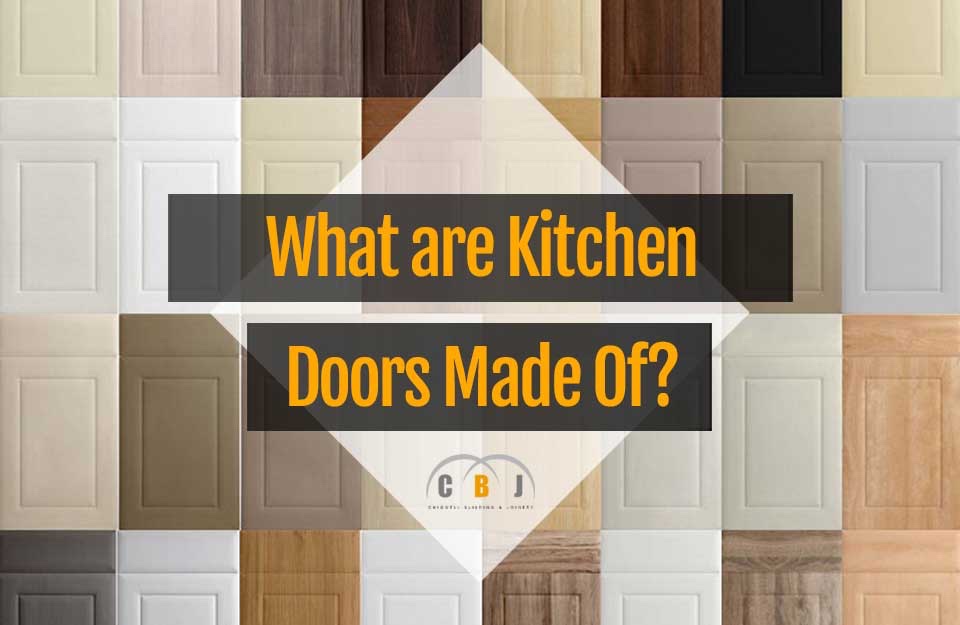News
How to Waterproof MDF
Author Chigwell Building & Joinery
Date 30/08/2022
MDF is a popular alternative to natural wood utilised in various settings.
MDF is denser than plywood, another synthetic wood, and a relatively cheaper option.
One major problem with MDF is its low tolerance to humid and moist conditions. It tends to absorb water which destroys the material.
In this article, we’ll take an in-depth look at MDF and outline steps to waterproof it effectively.
Table of Contents
- What is MDF?
- Is Standard MDF Waterproof?
- Benefits of Using MDF
- Making MDF Waterproof
- Tools Required
- Conclusion
What is MDF?
Medium-density fibreboard (MDF) is a type of engineered wood.
It consists of wood by-products, shavings, sawdust, and other residual fibres.
The wood by-products are dried and grounded into powder.
It is then mixed with wax and resin and subjected to a high-pressure press into flat panels by mechanical means.
There are various types of MDF, including:
- Standard MDF
- Ultralight MDF
- Moisture Resistant MDF
- Fire Retardant MDF
- Exterior Grade MDF
- Valchromat MDF
- Melamine Faced MDF
Is Standard MDF Waterproof?
Standard MDF is not waterproof, and only short term exposure to water will damage it because it will typically be absorbed.
This exposure will cause the MDF to swell, rendering it useless.
MDF is made of wood fibre bound together by resin adhesive, making it moisture resistant.
But it is not waterproof, and little cuts or prolonged exposure to water will damage it.
For this reason, standard MDF is suited for indoor use, such as for cabinets, shelves, and other objects in places with low moisture or humidity.
Remember that waterproofing your MDF does not offer protection from prolonged exposure to water however.
Benefits of Using MDF
Besides the fact that MDF is less expensive than plywood, there are other benefits to using MDF in your home.
They include:
- MDF's density and shape make it solid and less likely to warp out of shape.
- MDF is easy to drill and cut without damaging the surface. Its durability is due to its composition.
- It works well with carpentry adhesives and polyurethane glues. In addition, MDF glues easily to most materials.
- MDF can easily be fastened together with screws and nails without damaging the surface.
- It is easy to paint.
- MDF can easily be cut and designed to create decorative door panels and other features around the home.
- MDF is a perfect substitute for plastic laminate and veneer as it has the appearance of real wood without the cost.
- MDF is resistant to termites due to the chemicals treatments (such Boric acid, Borax, and urea-formaldehyde) used when manufacturing it.
- MDF is eco-friendly and can be recycled.
Making MDF Waterproof
There are two methods to waterproof MDF.
You can opt for using manufactured Moisture Resistant MDF, which is a little more expensive than standard MDF.
Or you can paint your MDF with moisture-resistant wood sealant or varnish.
Painting your MDF will require you to apply several coats of wood sealant and waterproof paint to its surface.
Either option provides the MDF with protection against moisture.
However, prolonged exposure to water will damage the MDF regardless of the protection provided.
Tools Required
- A quality wood sealant or varnish
- Paintbrush
- Sandpaper
- Roller tray liner
- Roller tray
- ⅜ inch Roller cover
Step One: Prepare Tools
Fix your ⅜-inch roller cover into its roller.
A ⅜-inch roller is recommended to maximise the spread of the paint on the MDF board.
Place a roller tray liner inside the roller tray.
Step Two: Apply Sealer
Apply the sealer to the edges using the paintbrush.
Ensure that all edges are properly covered, and that there’s no drips.
Proceed to apply the sealant to the surface.
We recommend applying at least two coats to the MDF surface.
Let it dry for at least 5 hours.
Clean the surface of the MDF and prepare tools for painting.
There are different sealants for waterproofing.
The most popular method, and the one recommended is primer sealant.
Other methods of sealant include:
Bondo technique
This method involves applying the Bondo filler across the edges and surface of the MDF.
This provides an adequate seal.
The only drawback is Bondo dries easily, and may not be suitable for larger jobs.
Water & glue technique
The technique is cheap and very effective.
It involves mixing water and glue in a container before applying it to the MDF as a sealer.
The only setback of this method is that you may need to add another coat after it has dried, as it’s not always visible during application.
Glazing putty technique
Glazing putty is a great sealer and easy to sand after painting.
It’s not as hard as the Bondo substance however.
Primer technique
Primers are the recommended sealer as they help bond the waterproof coat to the MDF.
Step Three: Apply Moisture-Resistant Paint
The next step is applying the first moisture-resistant paint coat on both sides.
You can sandpaper the edges to ensure a smooth feel.
Once the coat is dried, it is recommended to apply a second coat to ensure the MDF is properly covered.
Paint the edges of the MDF boards too.
Leave the paint to dry for at least two days.
Conclusion
As mentioned above, MDF is a solid alternative to natural wood.
It is also your best bet if you want something aesthetically pleasing, yet more economical than plywood.
Remember, you don't want to expose MDF to humid or moist conditions, so you should be mindful of where you’re going to use it.
There are types of MDF that can work in harsh or wet weather conditions, so you should always do your research before using this highly versatile building material.
What Are Kitchen Doors Made Of?
Author Chigwell Building & Joinery
Date 01/08/2022
As soon as you walk into a kitchen, the first thing you notice is the kitchen cabinet doors.
The style, the material and colour are all important aspects, and this inevitably makes it even more important to choose carefully and wisely.
It's also critical to take into account the various pros and cons that different materials offer.
This will help you strike the right balance between style and quality.
Table of Contents
- Solid Wood
- Melamine Faced Chipboard (MFC)
- Veneered Chipboard
- Veneered MDF
- Foil Wrapped MDF
- Painted MDF
- Vinyl Wrapped MDF
- Acrylic Faced MDF
- Toughened Safety Glass
- Conclusion
Solid Wood
Image credit: Pixabay
Solid hardwood is one of the most expensive options.
But there's no denying that you'll be investing in durable and high quality kitchen cabinet doors.
Solid wood is able to put up with the daily wear and tear that kitchen doors are subjected to.
This includes the numerous bumps and knocks that are even more common if you have children or pets.
Another key advantage of solid wood doors is they always stay in style as they have a timeless beauty.
Moreover, there are countless colours to choose from.
For many people, nothing beats that natural look that can be offered by the various types of solid wood options.
These include cherry, oak, pine, hickory, birch and walnut.
Solid wood doors are also customisable according to one's preferences.
Despite the numerous advantages of solid doors, one will need to bear in mind that besides being expensive, they also require considerable maintenance.
A waterproof finish should be given to such cabinets, and it's crucial to clean them with specialised non-abrasive products.
Such solid wood doors also have the drawback of being reactive to humidity, so they can warp and crack.
Melamine Faced Chipboard (MFC)
Image credit: CBJ Ltd
MFC kitchen doors are another popular option as they are affordable, yet very stylish.
If you cannot afford hardwood doors, melamine face chipboard is a great alternative as they're far more budget-friendly.
They're also available in a wide variety of colours, from a natural finish to a more contemporary look.
MFC is made from resin coated particles of softwood.
Such particles are evenly spread out over a flat plate.
Then, they are bonded together by applying extreme high pressure.
Subsequently, the melamine face is laminated on top as a decorative finish.
During this manufacturing process various textures can be applied.
This allows for a variety of finishes that can be achieved, including matt, gloss and embossed wood grain effects.
Veneered Chipboard
Image credit: Mebelissimo
Veneered chipboard is a fairly common kitchen door material.
A veneer is a thin layer of timber which is bonded to the chipboard and then sealed with stain and/or lacquer.
Veneered chipboard cabinet doors are quite affordable and durable.
Another advantage is they preserve consistency of the grain colour and pattern.
Veneer cabinets can provide both the look as well as the feel of natural wood, and they are easy to maintain.
However, it's important to remember that they should not be subjected to excess moisture.
If this occurs, the veneer can loosen from the substrate, resulting in a bubbled look in certain areas.
Veneered MDF
Image credit: Builder Depot
Similar to veneered chipboard, the main difference is the veneer is bonded to a medium density fibreboard substrate, instead of chipboard.
MDF is considerably durable and yet relatively inexpensive, making it a great option for many.
Veneered MDF doors do not require specialist care as they can be maintained simply by wiping down with a soft, lightly dampened cloth.
It's important to avoid excessive exposure to water as they are vulnerable to moisture penetration.
Any nicks and scratches can be buffed out easily in many cases.
So it's safe to say that such doors are resistant to warping and are reasonably durable.
Foil Wrapped MDF
Image credit: Kitchen Findr
In this case a layer of vinyl or foil is wrapped and bonded onto an MDF substrate.
Foil consists of paper mixed with resin, whereas vinyl is a thin layer of plastic.
Both are commonly used to manufacture kitchen cabinet doors as they offer increased durability coupled up with various stylish options.
This material is very versatile as it can be printed in countless different ways.
From natural wood grains to a simple single colour finish, as well as opting for matt or high gloss depending on one's preferences.
Painted MDF
Image credit: Advanced Timber Finishing
Painted MDF is another option which is fairly common.
Applying several coats of high quality paint or lacquer to the MDF substrate offers a greater choice of colours and styles to suit diverse preferences.
First the doors are primed and cured.
Following such a process the doors are finely sanded, and a top coat is applied.
Subsequently, the doors are returned to the oven for additional curing.
This helps to create a tougher, more durable surface.
Needless to say, the most obvious benefit of such kitchen doors is there's countless colours one can choose from.
Having said that, it is important to be realistic and choose a colour which will have a timeless appeal.
You do not want to end up getting bored of it or find it looks dated in a few years time.
Some colours may go out of fashion, so bear this in mind when choosing.
Painted MDF doors have the advantage of lasting longer and you won't need to worry about peeling.
It's a good idea to store a pot of the colour matched touch up paint however, so in case of any chips or scratches you can repair them easily.
Painted MDF doors may end up being quite expensive if the kitchen is quite large.
So bear in mind that this is definitely not the option which can offer you the best in terms of durability.
Vinyl Wrapped MDF
Vinyl wrapped MDF has become one of the most popular options.
This material is relatively affordable, and yet it can still offer you considerable durability.
Vinyl wrapped doors are either compressed or composite wood doors, onto which a vinyl wrap is laid.
As a result, such doors are highly resistant to moisture and humidity, as well as changes in temperature, making them ideal for a kitchen.
Vinyl wrapped MDF is available in a wide range of colours and patterns, allowing you the possibility of being spoilt for choice.
Acrylic Faced MDF
Image credit: MIH Building Material
Acrylic faced MDF cabinet doors are a relatively cost effective option.
Such doors are made by applying a thin layer of high gloss acrylic to the MDF.
This is bonded to the substrate, offering a stylish and more durable finish to the doors.
Acrylic is a non-toxic material which is ideal to give a high gloss finish to kitchen doors.
It is particularly popular for those who have a rather small kitchen, as the high gloss finish will reflect light, making the kitchen look more spacious.
Cleaning and maintaining such cabinet doors is also simple.
One will not have to worry about cracking or chipping as this is highly unlikely with such a material.
Moreover, the vast range of colours that one can choose from is a great advantage.
The main drawbacks of acrylic faced MDF cabinet doors is that regular cleaning is often necessary.
Fingerprints, dirt and stains can be a common problem, and are easily visible on the glossy surface.
Toughened Safety Glass
Image credit: Pexels
Glass doors used to be very popular back in the day.
Over the years other materials started to be favoured, but lately glass doors are making a comeback.
Glass doors are made from toughened safety glass and can be quite costly, especially if you have a large kitchen.
Many people favour these doors because they allow you to see what's stored inside the cupboard without having to open them to find for what you need.
On the other hand, it's important to ensure you have a well-organised and tidy setup within the cupboards as everything will be in plain sight.
Such doors are relatively easy to clean and are scratch-resistant.
Moreover, they are not affected by heat or humidity.
Conclusion
Since there are so many different kitchen door material options available, it's a good idea to meet up with a kitchen cabinet specialist to discuss your needs.
They can help to find the right style option which will align with your particular preferences and budget.
Finding a material that's cost effective and able to fit into your home and lifestyle is important.
The kitchen is the hub of the home, so you want to get this important decision right the first time!



